University of Redlands Emergency Alert System
Alert Received: . For more information, visit: https://www.redlands.edu/alert/
University of Redlands
Common Name: Peach
Scientific Name: Prunus persica
Family: Rosaceae
Identification:
Habit: The peach Tree is very fast growing. The maximum height is about 4 to 6 meters and the diameter of the trunk is about 10-17 centimeters in diameter. Peach have a shorter lifespan than most trees. They are commonly used in orchards for about 10-20 years. Fruit can be produced as early as 3 years, depending on their resistance to diseases (Gilman 1994). Peaches generally grow best in well drained sandy loams, but can be found in thickets, roadsides, and other disturbed habitats.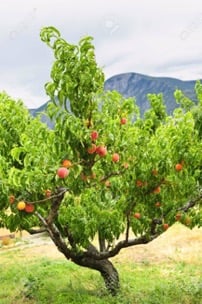 Figure 1. Peach Tree
Figure 1. Peach Tree
Leaves: The leaves of the peach tree are simple and oval shaped. The peach tree is deciduous. The leaves are green but turn to a yellow color in the fall before they drop. Peach tree leaves are longer than they are wide, hence oval. The leaves are usually flat and 5 to 10 centimeters wide by 10-20 centimeters long on average with straight veins (Mounzer 2008). They are arranged on the stems of the tree in an alternating pattern.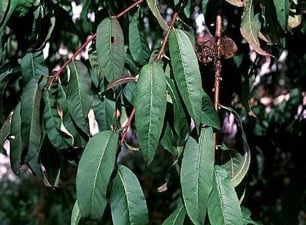 Figure 2. Prunus persica leaves
Figure 2. Prunus persica leaves
Twigs & Bark: Peach bark is a dark grey and brown color. It is smooth for the most part but has been observed to be rough in older peach trees (Virginia Tech Dendrology). New twigs are a green and red color but turn grey and brown as they age. The buds on the end of the twig growths are grey and sometimes fuzzy (Virginia Tech Dendrology).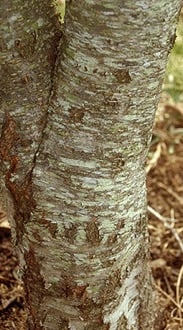 Figure 3. Peach tree bark
Figure 3. Peach tree bark 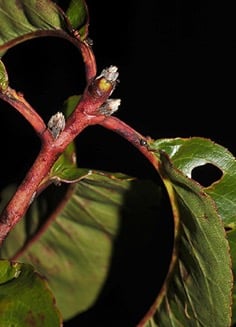 Figure 4. Peach tree twig with bud
Figure 4. Peach tree twig with bud
Flowers & Fruits: The flowers of the peach tree appear in the early spring and are bright pink and sometimes lavender or creme, arranged in a circular pattern consisting of many small petals. The flowers are small, averaging about one inch across. The fruits are round and average about 7 to 12 centimeters in length (Virginia Tech Dendrology). They are fuzzy and contain a brown pit that surrounds the seed with a wavy, ribbed pattern. The fruits are a reddish orange color on the outside and have a yellowish orange flesh (Gilman 1994).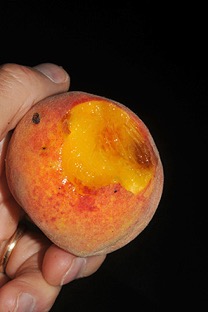 Figure 4. Peach tree fruit
Figure 4. Peach tree fruit 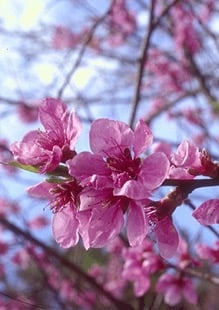 Figure 5. Peach tree flower
Figure 5. Peach tree flower
Where it’s from
Native range: The peach tree is not a native tree of North America. It is a native of Asia, specifically northwest China. It was believed to be introduced to North America by Spanish explorers, and once it was introduced to North America, Native Americans planted it and used the fruits commonly (Gilman 1994). Peach trees are commonly found in the warmer temperate areas of the world and are found in both the northern and southern hemispheres.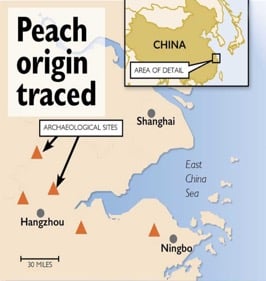 Figure 6. Map of peach tree origin
Figure 6. Map of peach tree origin 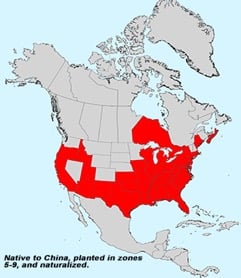 Figure 7. Map of peach tree distribution across America
Figure 7. Map of peach tree distribution across America
Ecological notes:
Peaches develop from a single ovary that ripens into an edible exterior. Typically, the peach tree has two ovules in the ovary, where only one becomes fertilized and develops into a seed. This causes half of the fruit to become larger than the other in size and appearance. Not only that but, there are many environmental problems that interfere with a peach tree fruit set. For instance, the peach tree has a common disease called the peach curl, running the leaves of the trees as seen in fig. 8. This type of disease is caused by the Fungus Taphrina deformans, which affects the fruit and causes the leaves to curl and become distorted (Broome, 2017). Additionally, severe winter conditions make a peach tree susceptible to late spring frost; killing the leaves (fig. 9). Most peach trees are self-pollinating, meaning they have both a male and female reproductive part, allowing more fruit reproduction to occur. It is known that certain pollinators, like bees, are to help pollinate them, but, these species are known to mainly self pollinate without the help of pollinators (Andrews, 2018). Peach trees thrive when placed in fertile soil and full ranged sun, they can grow in a wide range of habitats allowing them to be invasive outside their native range. 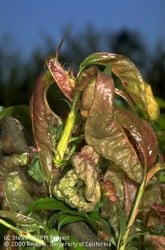 Fig 8. Leaf curl symptoms
Fig 8. Leaf curl symptoms 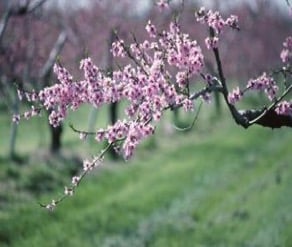 Fig 9. Late spring frost freezing fruit leaves
Fig 9. Late spring frost freezing fruit leaves
What we use it for
Traditionally, peaches from peach trees are used in a variety of desserts such as: peach pies, cobblers or jam. Historically, there have been thousands of varieties of peaches including Elberta, Redhaven and Halford, (Mounzer, 2008) which are yellow or white flesh peaches. Each producing their own nutritional value that are used to help with: skin care, teeth, bones, nervous system and much more (Sawe, 2017). The main producer of peach trees is China generating roughly about 11.9 million tons of production. The second and third producers were Italy and Spain coming in between 1.4-11.3 million tons of production (Sawe, 2017 ). The fourth major producer is The United States with the major contributing states being in California (78% of total peach production by weight), Georgia and South Carolina (Peaches, 2019). Most peaches are harvested in July and August which means they are typically expensive outside of those month but cheap during the months of production. Yet they have a relatively consistent economic income (Gilleski, 2018). Overall China, Italy, Spain and the United States are historically known as the major procedures and distributors of peaches worldwide due to coastal temperatures that help peach trees thrive in.
References
Biographer:
Abby Nordquist & Kalli Vellis, BIOL 238: Evolution, Ecology, & Behavior, Spring 2019.